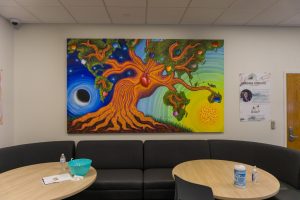The UTSA biology lab is working to find a vaccine for Francisella tularensis (FT), a form of deadly bacteria that has been developed into biological warfare.
Like anthrax, the FT bacteria can be developed into an aerosol form and used as a biological terror weapon. If it is inhaled, FT is so potent and dangerous that as little as 10 single bacteria can be lethal.
“To put [the potency of FT] into perspective, we have hundreds of thousands of bacteria on our hands right now,” UTSA professor of microbiology Dr. Karl Klose said. “
Imagine trying to pull just 10 bacteria off-it just boggles your mind.” Klose studies FT, as well as other strains of the bacteria, in his biology lab.
When FT infects a host through the skin, it causes tularemia, also called rabbit fever because it is a disease commonly found in rabbits and other mammals.
According to the Center for Disease Control (CDC), about 200 human cases of tularemia are reported each year in the United States. Most cases occur in the south-central and western states, and nearly all cases occur in rural areas.
Humans can contract tularemia by handling animal carcasses, being bitten by an infected insect (such as a tick) or from eating or drinking contaminated food or water.
The CDC reports that symptoms may vary depending on how a person was exposed to the bacteria. Possible symptoms include skin ulcers, swollen and painful lymph glands, inflamed eyes, sore throat, mouth sores, diarrhea or pneumonia.
If the bacteria are inhaled, symptoms can include abrupt onset of fever, chills, headache, muscle aches, joint pain, dry cough and progressive weakness. People with pneumonia can develop chest pain, difficulty breathing, bloody sputum, and respiratory failure. Tularemia can be fatal if the person is not treated with appropriate antibiotics.
Because FT causes such dramatic effects when inhaled, it has been manufactured as a bio-terror weapon in many countries. After World War II, the United States, Japan and the Soviet Union created FT biological terror weapons.
“In 1971, the United States and Russia agreed to stop manufacturing and to destroy the stockpiles of biological weapons, but Russia didn’t,” Klose said. “They kept right on producing. They were still working on bio-weapons until the fall of the Soviet Union. So, there’s a lot of fear that stock piles fell into the hands of various nefarious hands.”
However, Klose said that while making FT into a weapon is possible, the likelihood of it actually being used is very small.
Although the bacteria is similar to anthrax in some ways, anthrax is much more “hardy” than FT.
“Anthrax spores last forever. They are a dormant form of the organism,” Klose said. “They have pulled anthrax spores out of ancient tombs in Egypt, and they are just the same now as they were then.”
“As gram-negative bacteria, FT does not form spores. If you were going to choose an organism that you were going to do something illicit with, I am not sure FT would be your first choice,” Klose said.
FT does not have a long shelf-life, making it difficult to store and disseminate. However, it does not need many bacteria to create disease, and, like anthrax, once it has been inhaled, it can be lethal.
“Your lung is a very special environment, and the immune cells there are very special,” Klose said. “So, the trafficking of FT through the lung is different than if the disease had been contracted through the skin.”
Dr. Xhavit Zogaj, a scientist researching FT species in the biology lab, said that the fear of FT is not only founded in the bio-terror threat. Because the bacteria are naturally occurring, anyone who has contact with infected mammals could get the disease.
The FT tularensis is the subspecies that is toxic and infectious to humans. In the UTSA lab, researchers work with a different strain of the bacteria, FT novicida.
“We are trying to understand the biology of these organisms, and at the same time we’ll know more about the high pathogenic strain,” Zogaj said.
“Sooner or later we will be able to identify genes, which encode the pathogenic factors and cause the disease. Then, we will have a target for the vaccine.”
The novicida subspecies is similar enough to the tularensis subspecies that researchers can safely experiment with novicida, yet yield the same results as if they were working with the more virulent form, tularensis.
“Novicida is fatal to animals, but safe for humans,” Klose said. “We don’t know why, but finding out is one of our goals in the lab and could eventually lead to us finding a potential vaccine.”
Tularemia is so dangerous because it has learned to evade macrophages, the cells of the human immune system that search the body looking for disease-causing bacteria.
“[Macrophages] engulf and destroy [the bacteria] inside a special compartment in the microphage called a phagosome,” Klose said. “They are basically the front line of defense in your body against disease.”
FT has figured out not only how to escape being killed by the phagosome, but how to use the microphage as a factory to reproduce. FT begins to replicate very quickly and disseminates throughout the body.
“The emphasis on the success of the macrophages is one of the major weak points of the human immune system,” Klose said. “This is also how anthrax replicates.”
The major goal of the biology lab is to eventually find a vaccine for FT; however, discovering a vaccine is a long, difficult process.
UTSA doctoral student Jeff Barker studies how the FT evades the human immune system.
“We’ve been trying to figure out the toxicity of this organism and how that relates to the virulence factor,” Barker said. “No one knows how or why FT live inside the macrophage. However, we’ve been able to identify the specific proteins responsible for this virulence factor.”
“If we can understand what their role is, we can essentially shut down the bacteria and prevent it from killing cells. Hopefully this research will lead to antibiotic therapies and vaccine candidates,” Barker said.
Klose said that his lab receives funding by the NIH to develop with vaccines against tularemia.
“Through basic research we can identify different proteins and genes that will help us know how to cripple the organism to find a vaccine,” Klose said.
“Our goal is to find a vaccine that is effective for all kinds of tularemia, but for now, we are looking specifically at the inhaled version because of the bio-terror threat. We have some preliminary data that says some vaccine candidates might be good, and others not to so good.”
“In order to figure out how something works, we have to make it not work. To know what a gene does, we have to get rid of the gene and see what happens when it’s not there. That really tells you what the gene is responsible for,” Klose said.
Klose said he and his team have made some major break-throughs in their research. They discovered a trait that makes FT unique compared to any other organism on earth.
“All organisms on earth use and store energy; it allows us to live. One of the major storage units for our energy is Nicotinamide Adenine Dinucleotide (NAD). FT has a different pathway to biosynthesis than all other organisms on earth,” Klose said.
“That is a cool finding because it means there are properties in FT that can be used for therapeutic purposes-if FT makes a specific enzyme for NAD, we can target that enzyme and kill the FT.”
“You always want to try to find something unique about the organism you are trying to inhibit that doesn’t apply to humans. All the antibiotics we use target something specific to bacteria that humans don’t have. Therefore, you can kill off these organisms that are affecting you,” Klose said.
“We’re fascinated with the organisms that have figured out how to get around the immune system,” Klose said. “We are doing ground-breaking work here.”











